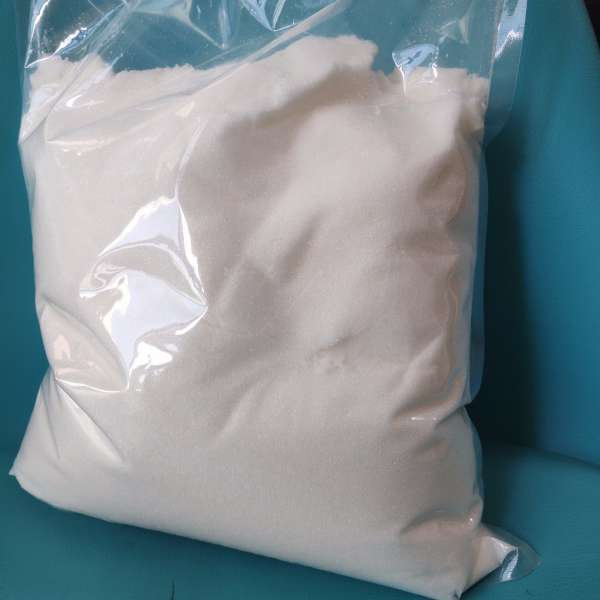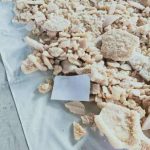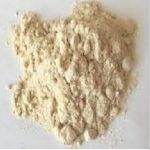New Cathinone
New Cathinone. Cathinone /ˈkæθɪnoʊn/ (also known as benzoylethanamine, or β-keto-amphetamine) is a monoamine alkaloid found in the shrub Catha edulis (khat) and is chemically similar to ephedrine, cathine, methcathinone and other amphetamines. It is probably the main contributor to the stimulant effect of Catha edulis, also known as khat.
Cathinone differs from many other amphetamines in that it has a ketone functional group. Other phenethylamines that share this structure include the stimulants methcathinone, MDPV, mephedrone and the antidepressant bupropion.
Khat is usually supplied as a bundle of leaves and fresh shoots wrapped in banana leaves. It is reported to have a sharp taste and an aromatic odour. Alcoholic extracts (tinctures) of khat have occasionally been reported, especially in ‘herbal high’ sales outlets and at music festivals.
New Cathinone. Khat (also known as qat or chat) comprises the leaves and fresh shoots of Catha edulis Forsk, a flowering evergreen shrub cultivated in East Africa and the South-West Arabian Peninsula.
Khat leaves are typically wrapped as a bundle in banana leaves. The principal active components in khat are cathinone and cathine (norpseudoephedrine) (see also Drug profile on synthetic cathinones).
Chewing khat releases these substances into the saliva; they are rapidly absorbed and eliminated. Both cathinone and cathine are closely related to amphetamine, and the pharmacological effects of cathinone are qualitatively similar to those of amphetamine, although it is less potent.
Only fresh leaves are chewed because cathinone soon degrades into old or dry plant material. The analysis relies on the characteristic appearance of khat and the presence of cathinone and/or cathine. Khat is not under International control but is scheduled by some Member States. Cathinone and cathine are listed in the 1971 United Nations Convention on Psychotropic Substances under Schedules I and III respectively.
The principal active component in khat is S-cathinone, otherwise known as (-)-2-aminopropiophenone or, more formally, S-(-)-2-amino-1-phenyl-1-propanone. Cathinone is labile and is transformed within a few days of harvesting to a dimer (3,6-dimethyl-2,5-diphenylpyrazine).
It is for this reason that khat needs to be consumed while still fresh. Cathine (1S, 2S-norpseudoephedrine), a further psychoactive substance, arises from the metabolism of cathinone in the mature plant. Apart from common plant products such as tannins, terpenes, flavonoids and sterols, a number of other substances occur in khat including smaller amounts of 1R, 2S-norephedrine and a large number of cathedulins (polyhydroxylated sesquiterpenes).
Both cathinone and cathine are close chemical relatives of the phenethylamines. Thus cathinone is the β-keto analogue of amphetamine. A large number of synthetic cathinone derivatives have been produced, some of which have found use as active pharmaceutical agents.
Structure
Cathinone can be extracted from Catha edulis, or synthesized from α-bromopropiophenone (which is easily made from propiophenone). Because cathinone is both a primary amine and a ketone, it is very likely to dimerize, especially as a free base isolated from plant matter.
New Cathinone. The structure of cathinone is very similar to that of other molecules. By reducing the ketone, it becomes cathine if it retains its stereochemistry, or norephedrine if its stereochemistry is inverted. Cathine is a less potent version of cathinone and cathinone’s spontaneous reduction is the reason that older khat plants are not as stimulating as younger ones.
Cathinone and amphetamine are closely related in that amphetamine is only lacking the ketone C=O group. Cathinone is structurally related to methcathinone, in much the same way as amphetamine is related to methamphetamine. Cathinone differs from amphetamine by possessing a ketone oxygen atom (C=O) on the β (beta) position of the side chain.
The corresponding alcohol, cathine, is a less powerful stimulant. The biophysiological conversion from cathinone to cathine is to blame for the depotentiation of khat leaves over time. Fresh leaves have a greater ratio of cathinone to cathine than dried ones, therefore having more psychoactive effects.
There are many cathinone derivatives that include the addition of an R group to the amino end of the molecule. Some of these derivatives have medical uses as well. Bupropion is one of the most commonly prescribed antidepressants and its structure is Cathinone with a tertiary butyl group attached to the nitrogen and chlorine attached to the benzene ring meta- to the main carbon chain.
Other cathinone derivatives are strong psychoactive drugs. One such drug is methylone, a drug structurally similar to MDMA.
Effects on health
The first documentation of the khat plant being used in medicine was in a book published by an Arabian physician in the 10th century. It was used as an antidepressant because it led to feelings of happiness and excitement. Chronic khat chewing can also create drug dependence, as shown by animal studies. In such studies, monkeys were trained to push a lever to receive the drug reward. As the monkeys’ dependence increased, they pressed the lever at an increasing frequency.
New Cathinone. Khat chewing and the effects of cathinone on the body differ from person to person, but there is a general pattern of behavior that emerges after ingesting fresh cathinone:
Feelings of euphoria that last for one to two hours
Discussion of serious issues and increased irritability
The chewer’s imagination is very active
Depressive stage
Irritability, loss of appetite and insomnia
There are other effects not related to the CNS. The chewer can develop constipation and heartburn after a khat session. Long-term effects of cathinone can include gum disease or oral cancer, cardiovascular disease and depression. The withdrawal symptoms of cathinone include hot flashes, lethargy and a great urge to use the drug for at least the first two days.
Biosynthesis
New Cathinone. The synthesis of cathinone in khat begins with L-phenylalanine and the first step is carried out by L-phenylalanine ammonia lyase (PAL), which cleaves off an ammonia group and creates a carbon-carbon double bond, forming cinnamic acid.[15] After this, the molecule can either go through a beta-oxidative pathway or a non-beta-oxidative pathway.
The beta-oxidative pathway produces benzoyl-CoA while the non-beta-oxidative pathway produces benzoic acid. Both of these molecules can be converted to 1-phenylpropane-1,2-dione by a condensation reaction catalyzed by a ThDP-dependent enzyme (Thiamine diphosphate-dependent enzyme) with pyruvate and producing CO2.[15] 1-phenylpropane-1,2-dione goes through a transaminase reaction to replace a ketone with an ammonia group to form (S)-cathinone. (S)-Cathinone can then undergo a reduction reaction to produce the less potent but structurally similar cathine or norephedrine, which are also found in the plant.[15]
Aside from the beta- and non-beta-oxidative pathways, the biosynthesis of cathinone can proceed through a CoA-dependent pathway. The CoA-dependent pathway is actually a mix between the two main pathways as it starts like the beta-oxidative pathway and then when it loses CoA, it finishes the synthesis in the non-beta-oxidative pathway. In this pathway, the trans-cinnamic acid produced from L-phenylalanine is ligated to Coenzyme A (CoA), just like the beginning of the beta-oxidative pathway. It then undergoes hydration at the double bond.
Bufo bufo venom for sale near you.
This product then loses the CoA to produce benzaldehyde, an intermediate of the non-beta-oxidative pathway. Benzaldehyde is converted into benzoic acid and proceeds through the rest of the synthesis. New Cathinone



